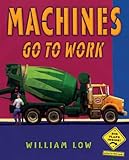
Dewey: 612.8
Machines Go to Work by William Low, Henry Holt, 2009
William Low brought a long-gone train station to life in his book Old Penn Station. Here, Low brings us working vehicles such as fire trucks, helicopters, backhoes, container ships, cement trucks and even railroad crossing signs that vibrate with color and strength.
This is not Little Toot, the anthropomorphic tugboat nor Thomas the Tank Engine. Low's brush strokes do suggest a presence and power as his machines rumble across the two page spreads. The reader can see the helicopter's rotors whirl and the front tire of a cement mixer deflating. Illustrations open with full page flaps to extend the reach of a backhoe or the length of the fire truck's ladder.
The narrative is set up to suggest a problem for each machine which is then gently resolved as the flap unfolds. A fire truck roars past cherry trees in full bloom, not because of a fire but to rescue a cat. A news helicopter races to the scene of a traffic tie-up but happily, an accident is not the cause of the problem.
The last two pages unfold to present a 4 page an aerial view of the city in eye-popping color. All the machines are visible from on high as they go about their work. It is fun to try and find them all. At the end of the book, small paintings of the machines are labeled along with some brief facts. The parts of the Cement Mixer are labeled: the water tank, the cement chute, the engine exhaust. The cement drum is "like a big mixing bowl. Just add sand, gravel, portalnd cement, water and mix."
Low paints with realistic and technical accuracy. People are there, operating these machines and giving the reader a sense of scale as well as the machine's purpose.
This is a "must-have" for school libraries and for young truck-boat-train-heavy machine enthusiasts.
Trained in traditional oil technique, Low used Adobe Photoshop and Corel Painter to create this book. He demonstrates how he works in this series of videos.
Fascinating.
Part 2
Part 3
Nonfiction Monday round up is at MotherReader today.
new posts in all blogs
 By: BookMoot,
on 3/23/2009
By: BookMoot,
on 3/23/2009
Blog: Book Moot (Login to Add to MyJacketFlap)
JacketFlap tags: machines, boats, trucks, city lfe, Add a tag
Viewing: Blog Posts Tagged with: city lfe, Most Recent at Top [Help]
Results 1 - 1 of 1
Blog: Book Moot (Login to Add to MyJacketFlap)
JacketFlap tags: machines, boats, trucks, city lfe, Add a tag
1 Comments on Nonfiction Monday: Machines Go to Work, last added: 4/6/2009
Display Comments
Add a Comment



I think my boys would love this book too. They are ALL about machines, vehicles... expecially trucks. Great review.